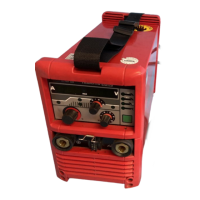14
Power sources for work in areas with increased electrical hazard (e.g. boilers) must be la-
beled with the symbol (Safety). However, the power source may not be located in such ar-
eas.
Risk of scalding due to leaking coolant. Switch off the cooling unit before disconnecting
connections for the coolant supply or return.
When handling coolant, observe the information on the coolant safety data sheet. The
coolant safety data sheet can be obtained from your service center or via the manufactur-
er's website.
In the event of crane attachment of the wirefeeder during welding, always use a suitable,
insulating wirefeeder hoisting attachment (MIG/MAG and TIG devices).
If the device is equipped with a carrier belt or handle, then this is used exclusively for trans-
port by hand. The carrier belt is not suitable for transport by crane, counterbalanced lift
truck or other mechanical lifting tools.
All lifting equipment (belts, buckles, chains, etc.), which is used in association with the de-
vice or its components, must be checked regularly (e.g. for mechanical damage, corrosion,
or changes due to other environmental influences).
The test interval and scope must at least comply with the respective valid national stan-
dards and guidelines.
There is a risk of colorless, odorless shielding gas escaping without notice if an adapter is
used for the shielding gas connection. Use suitable Teflon tape to seal the thread of the
shielding gas connection adapter on the device side before installation.
Requirement for
the shielding gas
Especially with ring lines, contaminated shielding gas can cause damage to equipment and
reduce welding quality.
Meet the following requirements regarding shielding gas quality:
- Solid particle size < 40 µm
- Pressure condensation point < -20 °C
- Max. oil content < 25 mg/m³
Use filters if necessary.
Danger from
Shielding Gas
Cylinders
Shielding gas cylinders contain compressed gas and may explode if damaged. Shielding
gas cylinders are an integral part of the welding equipment, so they must be handled very
carefully.
Protect shielding gas cylinders with compressed gas from excessive heat, mechanical im-
pact, slag, open flames, sparks, and arcs.
Mount the shielding gas cylinders vertically and secure them in accordance with instruc-
tions so they cannot fall over.
Keep shielding gas cylinders away from welding or other electrical circuits.
Never hang a welding torch on a shielding gas cylinder.
Never touch a shielding gas cylinder with an electrode.
Risk of explosion: Never weld on a compressed shielding gas cylinder.
Always use suitable shielding gas cylinders for the application in question and the correct
matching accessories (controller, hoses, and fittings, etc.) Only use shielding gas cylinders
and accessories that are in good condition.
If a valve on a shielding gas cylinder is open, turn your face away from the outlet.
